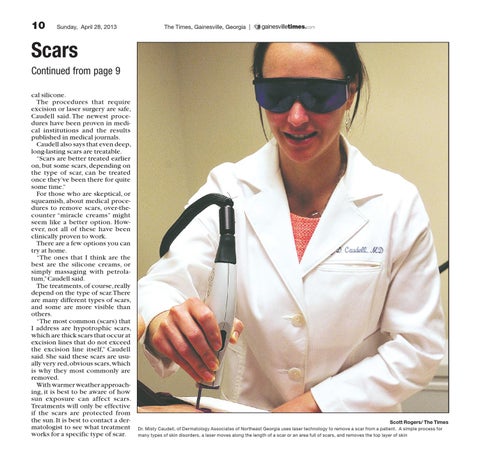10
Sunday, April 28, 2013
The Times, Gainesville, Georgia |
gainesvilletimes com
Scars Continued from page 9 cal silicone. The procedures that require excision or laser surgery are safe, Caudell said. The newest procedures have been proven in medical institutions and the results published in medical journals. Caudell also says that even deep, long-lasting scars are treatable. “Scars are better treated earlier on, but some scars, depending on the type of scar, can be treated once they’ve been there for quite some time.” For those who are skeptical, or squeamish, about medical procedures to remove scars, over-thecounter “miracle creams” might seem like a better option. However, not all of these have been clinically proven to work. There are a few options you can try at home. “The ones that I think are the best are the silicone creams, or simply massaging with petrolatum,” Caudell said. The treatments, of course, really depend on the type of scar. There are many different types of scars, and some are more visible than others. “The most common (scars) that I address are hypotrophic scars, which are thick scars that occur at excision lines that do not exceed the excision line itself,” Caudell said. She said these scars are usually very red, obvious scars, which is why they most commonly are removed. With warmer weather approaching, it is best to be aware of how sun exposure can affect scars. Treatments will only be effective if the scars are protected from the sun. It is best to contact a dermatologist to see what treatment works for a specific type of scar.
Scott Rogers/ The Times Dr. Misty Caudell, of Dermatology Associates of Northeast Georgia uses laser technology to remove a scar from a patient. A simple process for many types of skin disorders, a laser moves along the length of a scar or an area full of scars, and removes the top layer of skin
